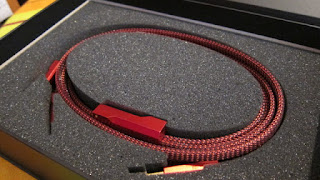Kingrex are known the world over due to the massive success of the T20 Tripath amplifier, since then kingRex have continued to produce highly affordable headphone amplifiers and DACS.
The latest addition to the Kingrex portfolio is a new range of high quality USB cable, ideal for usage with the new UD-384 32 bit DAC and the U power battery powered supply.
We at Kingrex always strive to bring you something a bit more
special, using our expertise and knowledge we applied our craft when designing
these new USB cables simply because in traditional Kingrex fashion we wanted to
bring you the best we could offer.
Our USB cables feature these two important performance enhancing features
.
l Signal/power separation
l Cryogenic treatment.
By including these two extra important ingredients in our new USB
cables, Kingrex have once again been able to offer you a product that not only
looks stunning but it has the sound quality to match.
The Unstoppable
trend- USB HiEnd
The USB DAC device should be the most popular choice for most of
users as it has two advantages that no one would deny.
1. Convenience – As
almost everyone’s PC or Mac should have the USB port, using USB DAC will be
very easy for all PC users.
2. Cut off the noise – The most reason for
audiophile reject using the computer as source because it might have ripple,
noise, high frequency radiation, jitter, and unstable power voltage output.
All
these problem will cause music with noise and unclear background none of these
could be endured. As the USB DAC is external device, it will decrease the
affection from the PC substantially. No loss or no distortion is the most
important thing while signal transition. The USB cable will play very important
role when signal transition.
The characteristics
and benefits of cryogenic treatment
Cryogenic treatment
is the process of treating work pieces to cryogenic temperatures (i.e. below
minus 196 degree C or minus 320 degree F). It is a programmable treatment
developed in the past 20 years by Jeff Levin (with a PhD in physics) of MIT and
R. F. Barron (with a PhD in metallic material science) of University of Louisiana
to remove residual stresses after annealing and other processes on steels. In
the treatment, liquefied nitrogen is used to lower the temperature of a work
piece to minus 196 degree C and maintain such temperature for a period of time;
then, temperature is brought up slowly through programmable control to the room
temperature. Such treatment would change and improve the fine-grained internal
structure and the density distribution of a work piece; in addition, impurities
(such as minute carbides) are removed. Such treatment can make a work piece more
stable and more durable.
According the relevant research, the mass ratio of a
metal depends on different low temperatures and the minus 196 degree C is the
optimal low temperature to reach the goal of the most stable mass ratios of
metals. With the treatment of such temperature, the molecular structure may
become tidier, the density may be increased by the removal of the minute
carbides and hence the work piece may be strengthened. Moreover, the treatment
may be used to treat work pieces that have been formed without causing any
deformation and discoloring.
Furthermore, with regard to
the transmission of musical signals, because musical signals travel along the
surfaces of a musical instrument or a musical component, the surfaces may
become smoother due to the removal of impure minute carbides along the
surfaces. In other words, the effectiveness of the transmission of musical
signals would be improved substantially. Therefore, in the upshot, a better
effect of musical signal transmission may be achieved with the treatment.
You can purchase kingRex products here
http://mundoaudiofilo.com/shop/manufacturer.php?id_manufacturer=3



No comments:
Post a Comment